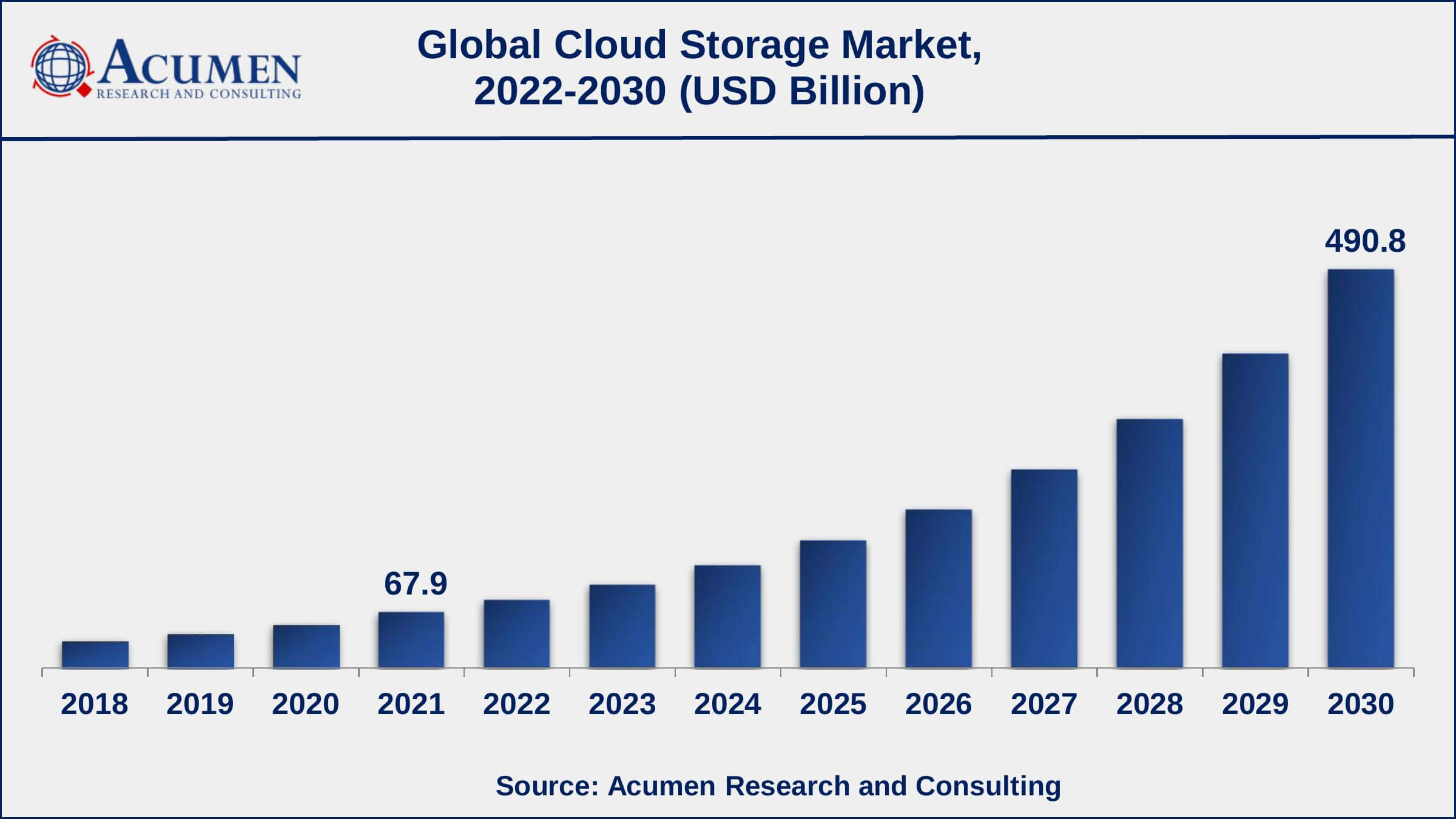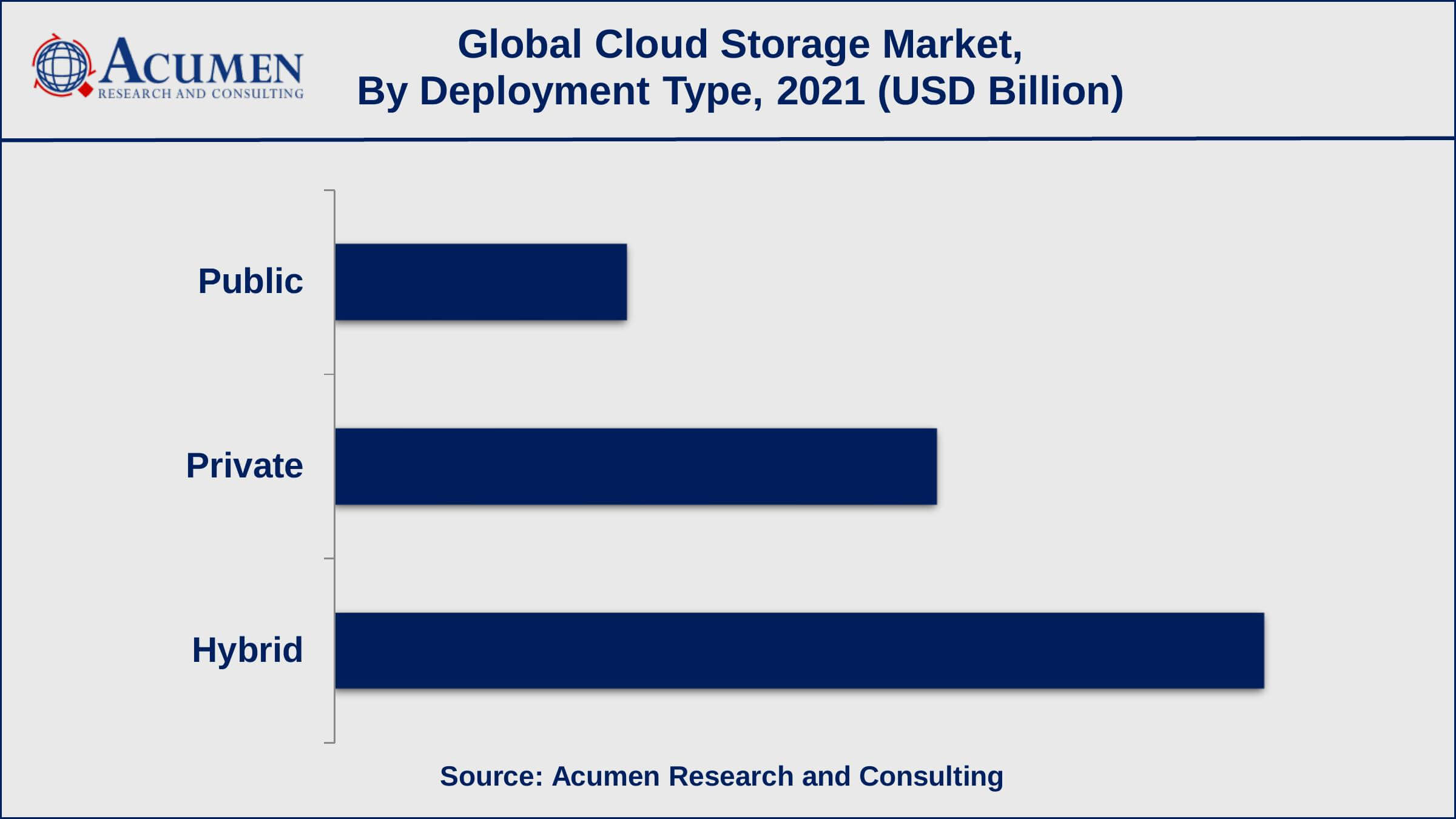Cloud Storage Market Size - Global Industry, Share, Analysis, Trends and Forecast 2022 - 2030
Published :
Report ID:
Pages :
Format :
Cloud Storage Market Size - Global Industry, Share, Analysis, Trends and Forecast 2022 - 2030
Report Coverage
- Industry Dynamics
- Market Size and Forecast Data
- Segment Analysis
- Competitive Landscape
- Regional Analysis with a Niche Focus on Country-Level Data
- High Level Analysis - Porter's, PESTEL, Value Chain, etc.
- Company Profiles of Key Players
- Option to Customize the Report As Per Your Specific Need
Request Sample Report
The Global Cloud Storage Market Size gathered USD 67.9 Billion in 2021 and is set to garner a market size of USD 490.8 Billion by 2030 growing at a CAGR of 24.8% from 2022 to 2030.
Cloud storage is a service that allows individuals and businesses to store data on remote servers that can be accessed via the internet rather than on their own local hard drives or servers. This allows users to access their data from any location with an internet connection, while also providing increased security, scalability, and cost-effectiveness over traditional storage methods.
Customers are typically charged by cloud storage providers based on their usages, such as the amount of data stored or the number of data transfers. Amazon Web Services (AWS), Apple iCloud, Google Cloud Platform, Microsoft Azure, Dropbox, and are some of the most popular cloud storage providers.
There are various types of cloud storage, such as object storage, block storage, and file storage, each of which is appropriate for different types of data and use cases. Cloud storage has grown in popularity for both personal and business purposes, and the market for cloud storage services is expected to expand further in the coming years.

Cloud Storage Market Report Statistics
- Global cloud storage market revenue is estimated to reach USD 490.8 Billion by 2030 with a CAGR of 24.8% from 2022 to 2030
- North America cloud storage market value occupied more than USD 28.5 billion in 2021
- Asia-Pacific cloud storage market growth will register a CAGR of more than 25% from 2022 to 2030
- Among component, the solutions sub-segment generated around 66% share in 2021
- Based on deployment type, the hybrid sub-segment achieved US$ 34.6 in revenue in 2021
- The growth of IoT and big data is a popular cloud storage market trend that fuels the industry demand

Global Cloud Storage Market Dynamics
Market Drivers
- Increasing demand for data storage
- Improved data accessibility and collaboration
- Enhanced data security
Market Restraints
- Data privacy and security concerns
- Dependence on internet connectivity
Market Opportunities
- Growing adoption of cloud technology
- Advancements in technology and favorable government regulations
Cloud Storage Market Report Coverage
| Market | Cloud Storage Market |
| Cloud Storage Market Size 2021 | USD 67.9 Billion |
| Cloud Storage Market Forecast 2030 | USD 490.8 Billion |
| Cloud Storage Market CAGR During 2022 - 2030 | 24.8% |
| Cloud Storage Market Analysis Period | 2018 - 2030 |
| Cloud Storage Market Base Year | 2021 |
| Cloud Storage Market Forecast Data | 2022 - 2030 |
| Segments Covered | By Component, By Deployment Type, By Enterprise Size, By Industry Vertical, And By Geography |
| Regional Scope | North America, Europe, Asia Pacific, Latin America, and Middle East & Africa |
| Key Companies Profiled | Alibaba Group Holding Limited, Amazon.com, Inc., Dell Technologies Inc., Dropbox, Google, Inc., Hewlett Packard Enterprise Development LP, IBM Corporation, Microsoft Corporation, Oracle Corporation, and VMware, Inc. |
| Report Coverage |
Market Trends, Drivers, Restraints, Competitive Analysis, Player Profiling, Covid-19 Analysis, Regulation Analysis |
Cloud Storage Systems Market Growth Factors
Increasing data storage demand is a major factor driving the global cloud storage market value. With the increase in digital data and the number of connected devices, there is an increasing demand for storage solutions to manage this data. Cloud storage can be less expensive than traditional storage solutions, especially for small and medium-sized businesses, which will help drive market growth. Improved data accessibility and collaboration are also expected to drive cloud storage market share growth. Users can access their data from any location with an internet connection, making it simpler for teams to collaborate and work remotely. In addition, cloud storage providers typically employ strong security measures such as encryption, backup and recovery systems, and access controls.
The major factors limiting industry growth are data privacy and security concerns. With data privacy becoming increasingly important, there are concerns about the security of sensitive data stored in the cloud. Different cloud storage solutions may be incompatible with one another, making switching between providers or integrating with other systems difficult.
One of the factors expected to generate numerous growth opportunities for the market in the coming years is the increasing adoption of cloud technology. As more businesses adopt cloud computing for their computing needs, the demand for cloud storage is expected to rise. Government regulations that require businesses to securely store sensitive data, such as GDPR and HIPAA, are also driving demand for cloud storage solutions.
Cloud Storage Systems Market Segmentation
The worldwide cloud storage market is categorized based on component, deployment type, enterprise size, industry vertical, and geography.
Cloud Storage Market By Component
- Solutions
- Object Storage
- File Storage
- Block Storage
- Services
- Consulting
- Integration and Implementation
- Training, Support, and Maintenance
- Managed Services
Solutions accounted for the largest market in 2021 and are expected to continue to do so in the future, according to our cloud storage industry analysis. This component is a significant component of the cloud storage industry and has dominated the market in recent years. This is due to the growing demand for cloud storage solutions from both businesses and individuals, who are attracted by the benefits of increased accessibility, improved data security, collaboration, and cost savings. Access controls, data backup and recovery, encryption, and collaboration tools are common features of cloud storage solutions. These solutions are available on a pay-as-you-go basis, allowing customers to only pay for the storage and services that they actually use.
Cloud Storage Market By Deployment Type
- Public
- Private
- Hybrid

The term "hybrid deployment" refers to the use of both on-premises storage (storage located within an organization's own physical facilities) and cloud storage to store and manages data. Because of its ability to provide the best of both worlds, hybrid deployment has gained significant market share in the cloud storage industry. Organizations can use hybrid deployment to benefit from the scalability, accessibility, and cost-effectiveness of cloud storage while still maintaining control over sensitive data by storing it on-premises. This is especially useful for organizations with strict compliance or security requirements. Additionally, a hybrid deployment can be a cost-effective solution for organizations with a large amount of data to store because it allows them to store less critical data in the cloud while keeping more sensitive data on-premises.
Cloud Storage Market By Enterprise Size
- Large Enterprises
- Small and Medium Enterprises
According to the cloud storage market forecast, large enterprises are the leading enterprise size segment between 2022 and 2030. Large enterprises frequently have a large volume of data to store and manage, as well as complex data storage needs. As a result, they are a key target market for cloud storage providers. Large enterprises are more likely to have the resources and technical expertise to implement cloud storage and reap the benefits of increased scalability, accessibility, and data security. Furthermore, large corporations are more likely to have the financial resources to invest in cloud storage solutions, which can be more expensive than traditional storage solutions. While large enterprises are the dominant enterprise size in the cloud storage industry, the market is expanding among small and medium-sized businesses (SMEs), as these organizations seek the cost savings and improved data management that cloud storage can provide.
Cloud Storage Market By Industry Vertical
- BFSI
- Government and Public Sector
- Healthcare and Life Science
- IT and Telecommunication
- Manufacturing
- Media and Entertainment
- Retail and Consumer Goods
- Others (Chemical, Energy & Utilities, Travel & Hospitality etc.)

The banking, financial services, and insurance (BFSI) industry vertical have dominated the cloud storage market. Because the BFSI industry generates and stores large amounts of sensitive financial data, it is an important target market for cloud storage providers. The BFSI industry can benefit from cloud storage in a variety of ways, including increased accessibility and collaboration, improved data security, and cost savings. Furthermore, the scalability of cloud storage can assist BFSI organizations in managing the large volumes of data generated, as well as accommodating periods of high demand. Cloud storage has become increasingly popular among BFSI organizations as they seek to modernize their data management systems and boost their overall competitiveness.
Cloud Storage Market Regional Outlook
North America
- U.S.
- Canada
Europe
- U.K.
- Germany
- France
- Spain
- Rest of Europe
Asia-Pacific
- India
- Japan
- China
- Australia
- South Korea
- Rest of Asia-Pacific
Latin America
- Brazil
- Mexico
- Rest of Latin America
The Middle East & Africa
- South Africa
- GCC Countries
- Rest of the Middle East & Africa (ME&A)
Cloud Storage Market Regional Analysis
North America has been at the forefront of cloud storage adoption and is a significant market for cloud storage. Many of the world's largest technology companies, as well as a large number of SMBs and large enterprises, call the region home, making it a key target market for cloud storage providers.
Because of the increasing adoption of cloud technology by businesses and individuals, the Asia-Pacific region has a rapidly growing cloud storage market. Countries such as China, India, Japan, and Australia have seen significant growth in the cloud storage market as a result of factors such as rising data storage demand, increased internet penetration, and the digitalization trend.
Cloud Storage Market Players
Some of the leading cloud storage companies include Amazon.com, Inc., Alibaba Group Holding Limited, Dell Technologies Inc., Dropbox, Hewlett Packard Enterprise Development LP, Google, Inc., IBM Corporation, Oracle Corporation, Microsoft Corporation, and VMware, Inc.
Frequently Asked Questions
What was the market size of the global cloud storage in 2021?
The market size of cloud storage was USD 67.9 Billion in 2021.
What is the CAGR of the global cloud storage market during forecast period of 2022 to 2030?
The CAGR of cloud storage market is 24.8% during the analysis period of 2022 to 2030.
Which are the key players operating in the market?
The key players operating in the global market are Amazon.com, Inc., Alibaba Group Holding Limited, Dell Technologies Inc., Dropbox, Hewlett Packard Enterprise Development LP, Google, Inc., IBM Corporation, Oracle Corporation, Microsoft Corporation, and VMware, Inc.
Which region held the dominating position in the global cloud storage market?
North America held the dominating position in cloud storage market during the analysis period of 2022 to 2030.
Which region registered the fastest growing CAGR for the forecast period of 2022 to 2030?
Asia-Pacific region exhibited fastest growing CAGR for cloud storage market during the analysis period of 2022 to 2030.
What are the current trends and dynamics in the global cloud storage market?
The current trends and dynamics in the cloud storage industry include increasing demand for data storage, improved data accessibility and collaboration, and enhanced data security.
Which component held the maximum share in 2021?
The solutions component held the maximum share of the cloud storage market.



